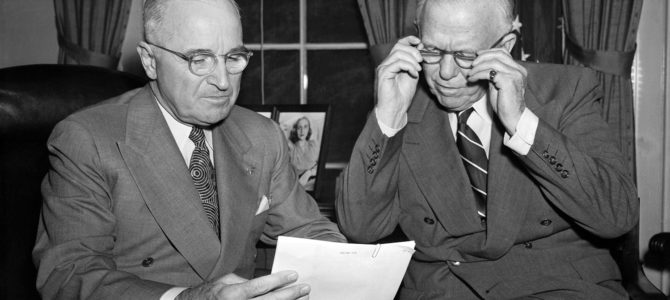The Trump administration’s effort to deregulate and reverse red tape among federal agencies has met resistance, mostly by the courts. Like both Bush and Obama administrations, regulations and rollbacks by Trump agencies are being ruled on in court on questions of failing to meet standards of the Administrative Procedure Act of 1946 (APA). If you’re following along with me in Hillsdale College’s online course on Congress, this week’s lesson explains how the APA was a consequential contributor to the decades of delegation of legislative power to executive agencies.
Passed in 1946, the APA became to the administrative process what the Constitution is to the legislative process. If the Constitution spells out how members of Congress are to conduct the process of legislation, the APA provides guidelines for the executive branch’s agencies in making rules.
This law is where courts get the “arbitrary and capricious” standard when ruling on regulations. It states that a court can overturn a regulation it determines is “arbitrary, capricious, an abusive digression, or otherwise not in accordance with law.” This means an agency can only act in accord with the evidence given and the expertise the agency possess.
For example, the U.S. Supreme Court recently agreed to take up a case on whether the Trump administration can ask about citizenship on the 2020 census. In a lower court, a federal judge in New York ruled that the census question, a regulation of the Commerce Department, would fail the “arbitrary” and “capricious” test. The APA instructs that agencies need to conduct analyses of the rule’s consequences and address serious critiques. This is just one example of at least 30 other deregulatory efforts within the Trump administration taken to the courts.
Under the informal rulemaking process established by this law, it’s fairly easy to publish a rule in the federal register, and difficult to undo one. Informal rulemaking only requires considering written public feedback on proposed rules submitted during a comment period. In undoing an administrative law, one must generate new evidence that supports a reduction of the regulatory burden. A court even ruled during the Reagan era that the president couldn’t just undo regulations he’d promised to roll back once elected. The so-called expertise of the previous administration held more power than newly elected President Reagan.
New administrative laws have always been challenged by the APA, but it’s becoming more common with every new administration. The combination of presidents who expand the power of the executive, and a gridlocked Congress who fails to take the reins, has lead to an increase regulatory rules falling under judicial review.
The bigger picture here isn’t whether the agencies under Trump are making good or bad rules, or that judicial review of regulations is a sign of ineptitude or haste. The larger problem is that the APA has transformed the basis of what rules we consider politically legitimate. The legitimacy and power of Congress derives from the fact that they were elected by the people. Thus, the laws made by Congress are established by consent, not by the expertise of bureaucrats. The APA’s resulting regulatory process lacks the elements of legitimacy.
The basis on which policy is made is crucial for understanding the nature of our political system. Over time, the regulatory procedures developed by agencies, no matter who the president is, replace the legislative process described in the Constitution. Consequently, we see an all-time high in lobbying groups, and increase in judges deciding legislation. When laws are made under the guise of agency expertise instead of the will of the people, they fail to serve the public interest, and lead to a different way of life for Americans.








